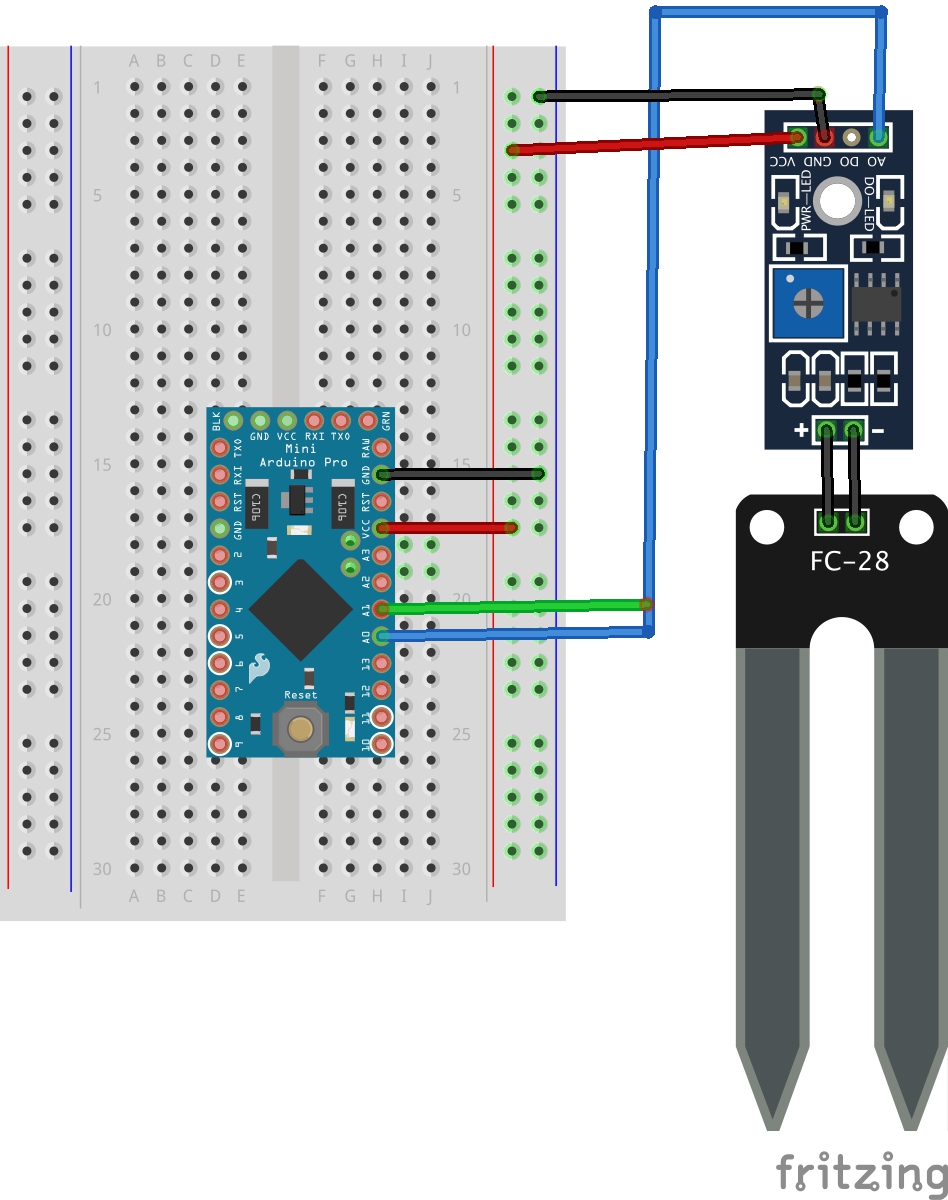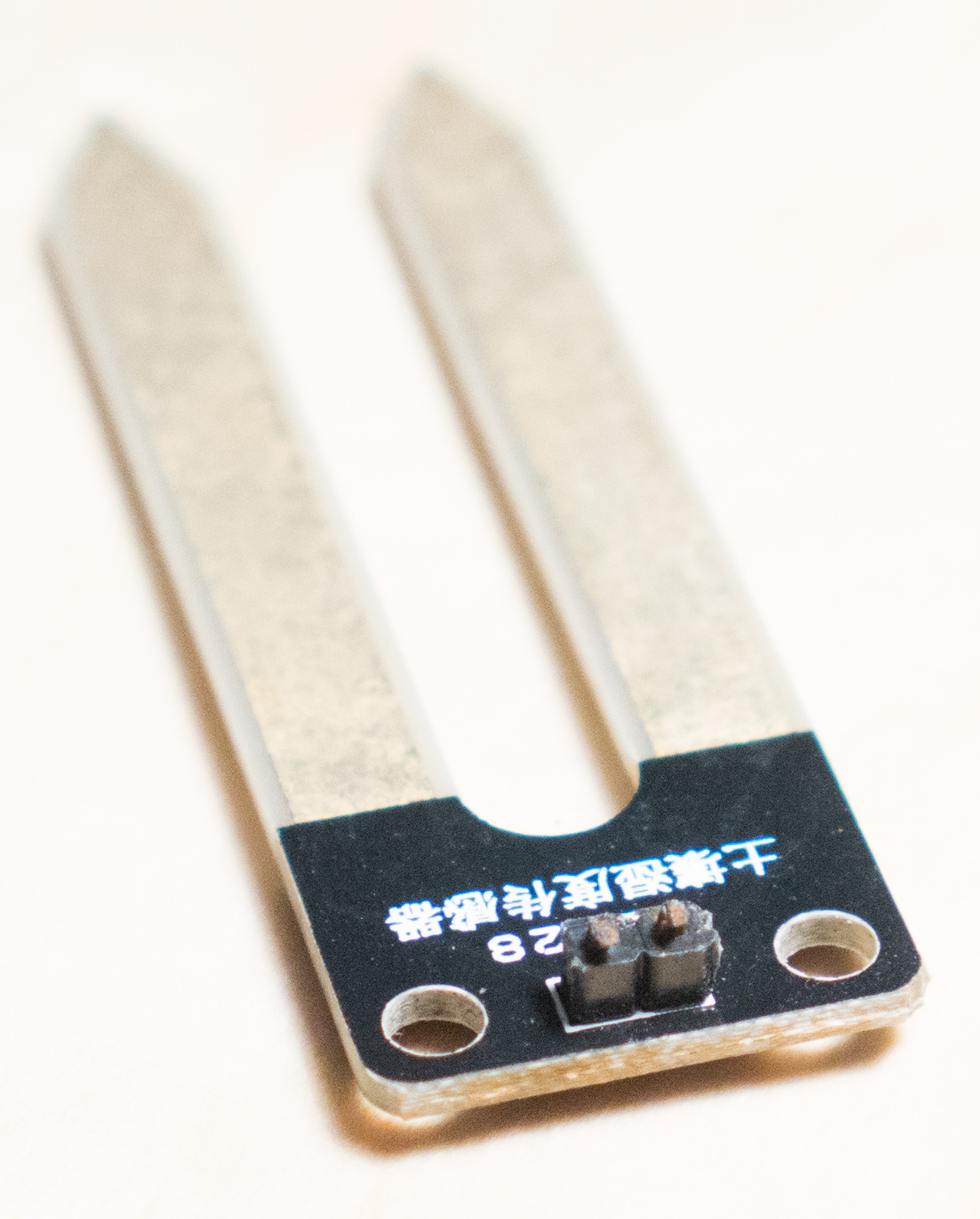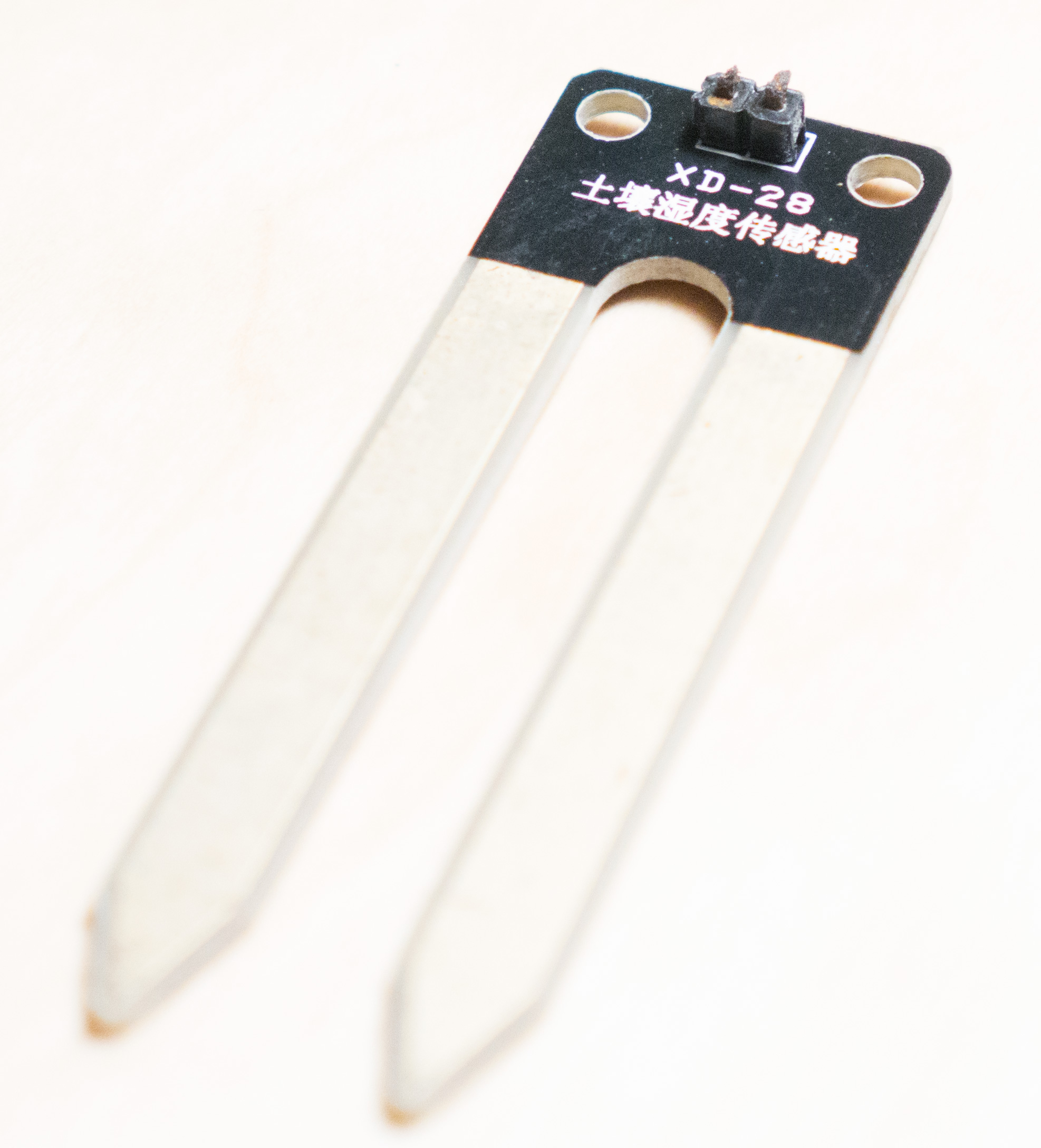Office plant monitoring
-
How did thinks go @Lars65 ?
I thought a bit more about this problem and I think I have come up with a pretty neat solution:
Throw away the chip on the moisture sensor and connect the "pitchfork" directly to the Arduino. Connect one prong to GND and one prong to an analog pin. No power pins are required.
https://codebender.cc/sketch:177182
The chip on the moisture sensor is basically a voltage divider. We get the same thing if we use the internal pull-up resistor on the Atmega processor.
EDIT: This means you can buy just the "pitchforks" really cheap: http://www.aliexpress.com/item/10pcs-Soil-Hygrometer-Detection-Module-Soil-Moisture-Sensor-Probes/2051713873.html -
@mfalkvidd , I think there has been many discussions on how these sensors corrodes over time.
I can see that this node sleeps between the readings and thus reduces corrosion as it only is powered during reading.
However, some threads I've read suggests that you alternate the power, as well, between readings.
Something you might implement in the code?
Also, do you have an estimate on the duration usage on the batteries for one of your plants?
Cheers! -
@Nicklas-Starkel If a measurement is taken once per hour, the sensor will only have power 0,008% of the time.
If corrosion still is a problem, and if the corrosion can be avoided by reversing polarity for every second measurement, I might add it. It would add complexity to the sketch though, and complexity is often the enemy of reliability.Also, for people wanting to use multiple sensors on the same mcu, reversing polarity would cut the possible number of connected moisture sensors in half since it would require two analog pins per sensor.
My estimated battery time on 2xAA for a Mini Pro with removed power led and voltage regulator is 1-2 years.
-
How did thinks go @Lars65 ?
I thought a bit more about this problem and I think I have come up with a pretty neat solution:
Throw away the chip on the moisture sensor and connect the "pitchfork" directly to the Arduino. Connect one prong to GND and one prong to an analog pin. No power pins are required.
https://codebender.cc/sketch:177182
The chip on the moisture sensor is basically a voltage divider. We get the same thing if we use the internal pull-up resistor on the Atmega processor.
EDIT: This means you can buy just the "pitchforks" really cheap: http://www.aliexpress.com/item/10pcs-Soil-Hygrometer-Detection-Module-Soil-Moisture-Sensor-Probes/2051713873.html@mfalkvidd said:
How did thinks go @Lars65 ?
I thought a bit more about this problem and I think I have come up with a pretty neat solution:
Throw away the chip on the moisture sensor and connect the "pitchfork" directly to the Arduino. Connect one prong to GND and one prong to an analog pin. No power pins are required.
https://codebender.cc/sketch:177182
The chip on the moisture sensor is basically a voltage divider. We get the same thing if we use the internal pull-up resistor on the Atmega processor.Hi @mfalkvidd and thank you very very much for your new version of the skecth for moisture sensors, its very clever ! i will test it as soon as possible
-
@Nicklas-Starkel last weekend one of my sensors broke. Both pins were completely corroded and broke just where I connect the dupont wires. I think I will use hot glue to protect the connectors, but I have also added alternating power to my single-sensor sketch. I have this sketch running on three sensors now.
https://codebender.cc/sketch:158460 -
In MySensors lingo, the Arduino is called a sensor. The part that MySensors calls a controller runs on a "real" computer, and gets information from the sensors. The controller usually handles reporting. The documentation at http://www.mysensors.org/about/network can probably give you a good overview.
-
Just some ideas to the corrosion issue (any photos?). If both pins were corroded, it may not be sufficient with polarity switching. Perhaps a simple active cathodic protection system could help. E.g. a +wire limited to a few uA and wrapped with some aluminium foil in the soil near the sensor?
I haven't yet got to it, but the plant monitoring is on pretty high on my list.
-
Just some ideas to the corrosion issue (any photos?). If both pins were corroded, it may not be sufficient with polarity switching. Perhaps a simple active cathodic protection system could help. E.g. a +wire limited to a few uA and wrapped with some aluminium foil in the soil near the sensor?
I haven't yet got to it, but the plant monitoring is on pretty high on my list.
-
@Nicklas-Starkel last weekend one of my sensors broke. Both pins were completely corroded and broke just where I connect the dupont wires. I think I will use hot glue to protect the connectors, but I have also added alternating power to my single-sensor sketch. I have this sketch running on three sensors now.
https://codebender.cc/sketch:158460@mfalkvidd
i am using your sketch for indoor plant monitoring but have modified the sleep time to one hour . the problem i am facing is that every alternate humidity reading i get is a 0
like
first reading ------ 67%
second reading ----- 0%
third reading ------65%
fourth reading ------- 0%and likewise
Please Guide
Thanks
-
@mfalkvidd
i am using your sketch for indoor plant monitoring but have modified the sleep time to one hour . the problem i am facing is that every alternate humidity reading i get is a 0
like
first reading ------ 67%
second reading ----- 0%
third reading ------65%
fourth reading ------- 0%and likewise
Please Guide
Thanks
-
Hello,
I'm on the same project personally...I using 2 battery... this part should work between 3.3 V and 5V...
finally with 2XAA we only have 3V, and the max value for me is 750 not 1023... did you get 1023 when into the water?
I use a gold plated sensor, and the plug will be into a seal to avoid corrosion and water to go in.
I use a sensbender where I connected on A3 the pin use for the soil moisture sensor.
Could you confirm that change the polarity help to avoid corrosion ???
thanks -
Hello,
I'm on the same project personally...I using 2 battery... this part should work between 3.3 V and 5V...
finally with 2XAA we only have 3V, and the max value for me is 750 not 1023... did you get 1023 when into the water?
I use a gold plated sensor, and the plug will be into a seal to avoid corrosion and water to go in.
I use a sensbender where I connected on A3 the pin use for the soil moisture sensor.
Could you confirm that change the polarity help to avoid corrosion ???
thanks -
Hello,
I'm on the same project personally...I using 2 battery... this part should work between 3.3 V and 5V...
finally with 2XAA we only have 3V, and the max value for me is 750 not 1023... did you get 1023 when into the water?
I use a gold plated sensor, and the plug will be into a seal to avoid corrosion and water to go in.
I use a sensbender where I connected on A3 the pin use for the soil moisture sensor.
Could you confirm that change the polarity help to avoid corrosion ???
thanks@doblanch said:
the max value for me is 750 not 1023... did you get 1023 when into the water?
I haven't tried in water. I don't care about the absolute value, I just note the reading when the plant needs watering and set a notification for that level. One of my plants needs water at about 70%, another at about 5%. It will vary wildly between different plant types, climate and soil composition.
The value for water will probably vary as well, depending on the water. Distilled water, rain water, tap water, salt water will all have different resistance.
And the value will vary depending on temperature and different Arduinos since the pull-up resistor is inexact.
-
@doblanch said:
Could you confirm that change the polarity help to avoid corrosion ???
thanksNo I can not. All my sensors change the polarity, so I can't tell if there is a difference. You'll have to experiment.
@mfalkvidd ok ; thanks I willl try :-)
-
@doblanch said:
Could you confirm that change the polarity help to avoid corrosion ???
thanksNo I can not. All my sensors change the polarity, so I can't tell if there is a difference. You'll have to experiment.
@mfalkvidd not false :-) I have to make some tries also. I bought a gold platined sensor, I hope that corrosion will be less...
-
@mfalkvidd Thanks for sharing! By looking at your corrosion photos I'd guess galvanic corrosion of pin header.
I think I'll solder my wires instead and put some sealing paint and/or hot glue over it. Polarity switch won't harm, but I'll wait with the cathodic protection for now.
-
@mfalkvidd
its on analog pin A0 -
@mfalkvidd
i have now connected two analog pins A0 and A1 of Pro Mini to the A0 pin of the soil sensor and now i am getting a constant reading of 98% humidity (in water or outside dry).please guide
Thanks
-
@mfalkvidd
this is how i have connected



